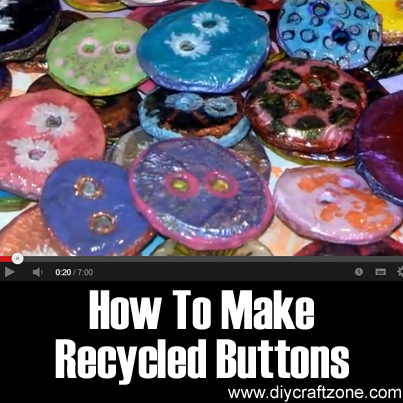 How To Make Recycled Buttons
How To Make Recycled Buttons
Photo – https://www.youtube.com/watch?v=1VPucAln69M
Long before they were used as fasteners for clothes, buttons (or button-like objects) were used as ornaments or seals. Some of the earliest buttons that were discovered came from the Indus Valley Civilization during the Bronze Age.
The earliest functional buttons were found in the tombs of conquering Hungarian tribes from the late 9th century. Buttons were also used in Germany in the 13th century. This soon became widespread with the rise in popularity of snug-fitting garments in 13th and 14th century Europe. [1]
This video tutorial by Jennibellie will teach you how to make easy decorative buttons that are made out of cardboard!
Tools and Materials Needed:
1. Cardboard (thin and thick)
2. Decorative Tissue Paper
3. Punching Tool
4. Scissors
5. Any tool that you can use to puncture holes
6. Mod Podge
7. Doule Sided Adhesive Tape
8. Acrylic Paint
9. Ink Pads
10. Glaze (Glossy Accents or Diamond Glaze)
11. Stencils
12. Q-tips
Comments/Suggestions:
1. It would be easier to just wrap the buttons with the decorative tissue paper and allow them to dry before punching the holes in the middle. That way, you won’t have to spend too much time puncturing the holes again.
2. Instead of throwing out your empty cereal boxes and cartons, you can at least make lots of pretty buttons out of them. They can be used in tons of DIY projects. You can even store a bunch of these buttons in a mason jar and keep them for future use!
3. Use small stickers with simple words written on them. You can also print out cartoon stickers or shadow silhouettes to make your buttons pop.
4. These decorative buttons are perfect for scrapbooking, but they can also be used to decorate gift boxes and picture frames.
5. You can also stick these buttons on your snapback caps. Use a fabric glue to put them in place. These will make your snapbacks look so cool. You can also try embellishing your backpacks and sneakers!
6. You can make your own Mod Podge by mixing 1 part regular Elmer’s glue with 1/2 part water.
Ok, here’s the video:
Reference:
